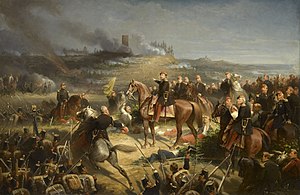| Battle of Solferino | |||||||
|---|---|---|---|---|---|---|---|
| Part of the Second Italian War of Independence | |||||||
 The Battle of Solferino, by Adolphe Yvon | |||||||
| |||||||
| Belligerents | |||||||
|
|
| ||||||
| Commanders and leaders | |||||||
|
|
| ||||||
| Strength | |||||||
|
9,162 cavalry 240 guns 1,562 cavalry 80 guns Total: 130,833[1] 320 guns |
119,783 infantry 9,490 cavalry 429 guns Total: 129,273 429 guns[1][2] | ||||||
| Casualties and losses | |||||||
|
France: 3,887 killed Including 117 officers 8,530 wounded 1,518 missing[3] Sardinia: 691 killed Including 49 officers 3,572 wounded 1,258 missing[3] Total: c. 28,000 |
7,679 killed Including 216 officers 17,567 wounded 9,290 missing Total: c. 40,000[3] | ||||||
The Battle of Solferino (referred to in Italy as the Battle of Solferino and San Martino) on 24 June 1859 resulted in the victory of the allied French army under Napoleon III and the Piedmont-Sardinian army under Victor Emmanuel II (together known as the Franco-Sardinian alliance) against the Austrian army under Emperor Franz Joseph I. It was the last major battle in world history where all the armies were under the personal command of their monarchs.[4] Perhaps 300,000 soldiers fought in the important battle, the largest since the Battle of Leipzig in 1813. There were about 130,000 Austrian troops and a combined total of 140,000 French and allied Piedmontese troops. After the battle, the Austrian emperor refrained from further direct command of the army.
The battle led the Swiss Jean-Henri Dunant to write his book A Memory of Solferino. Although he did not witness the battle (his statement is contained in an "unpublished page" included in the 1939 English edition published by the American Red Cross), he toured the field following the battle and was greatly moved by what he saw. Horrified by the suffering of wounded soldiers left on the battlefield, Dunant set about a process that led to the Geneva Conventions and the establishment of the International Red Cross.
- ^ a b Brooks 2009, p. 61.
- ^ Fink, Humbert (1994). Auf den Spuren des Doppeladlers. Berlin.
{{cite book}}: CS1 maint: location missing publisher (link) - ^ a b c Osterreichischen Militarischen Zeitschrift: Der Feldzug des Kaisers Napoleon 3. in Italien im Jahre 1859 (1865) (German translation of Campagne de l'Empereur Napoleon III en Italie.)
- ^ Evans, Richard J., The Pursuit of Power: Europe 1815–1914, Penguin: London, 2017, p. 242.